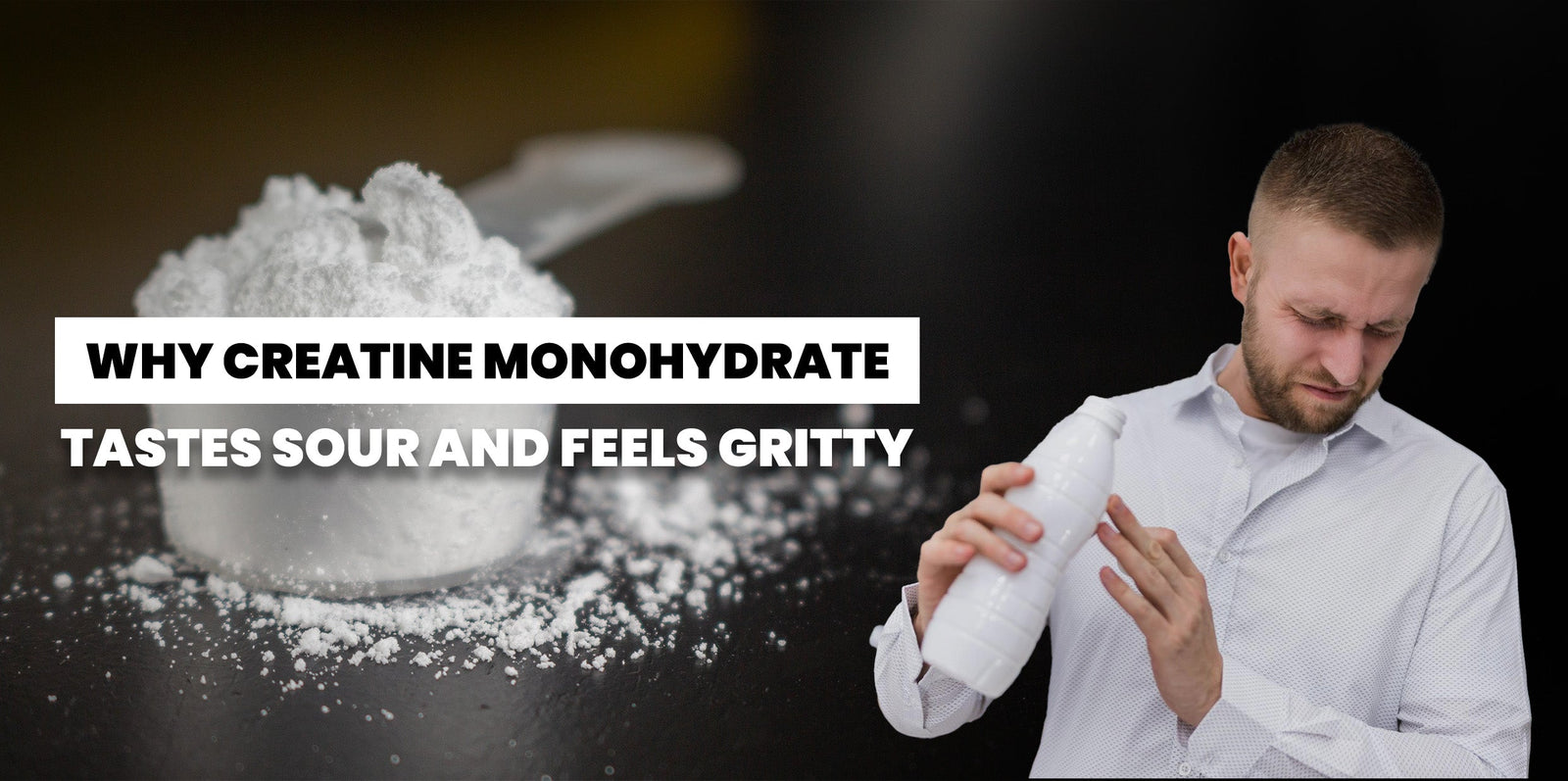Every gym-goer and Fitness Enthusiast is aware of the benefits of Creatine and how it fuels intense workouts. Some gym pros know the more in-depth advantages of creatine and use it to maximize results. For example, creatine helps boost cognitive and neurological function, making you focused and improving endurance for more intense training. It is often shown that oral creatine might reduce the frequency of dehydration, muscle cramping, and injuries to the muscles, bones, ligaments, and tendons.
However, there always has been an issue among gym peers about the aftertaste and gritty texture of creatine. Let’s dive into the untold truths behind these common complaints.
Creatine monohydrate, the most popular Creatine Form, is a natural supplement supporting muscle performance. However, it has limitations in water solubility. The sour taste isn’t due to spoilage or impurities. Creatine monohydrate itself has a slightly acidic taste.
Ever taken a sip of your creatine monohydrate mix and thought, "Why does this feel like sand and taste so sour?" You're not alone. Creatine monohydrate, despite being one of the most trusted and researched Fitness Supplements, often leaves users puzzled by its gritty residue and off-putting aftertaste. But is this a sign of poor quality, or is there more to the story? Then what is the reason?
Why Creatine Doesn’t Dissolve Completely
The gritty residue in your shaker isn’t just an annoyance; it’s a direct result of creatine monohydrate’s Chemical Structure. Creatine is hydrophilic, meaning it loves water, but it’s not entirely soluble. Here’s why:
- Purity Matters: Pure creatine monohydrate, which is essentially a powdered form of a natural compound, has limited solubility. Unlike sugar or salt, which dissolve effortlessly, creatine needs time and proper mixing to break down in water.
- Water Temperature Makes A Difference: Cold water slows down the dissolving process. If you’re mixing your creatine in ice-cold water, you’re more likely to experience that gritty texture. Using warm water can significantly improve solubility.
- Dosage And Saturation: Many users add too much creatine to their drink. The solubility limit of creatine in water is about 5 grams per 500 ml. Exceeding this can leave undissolved particles at the bottom of your glass.
Pro Tip: For a smoother drink, dissolve your creatine in warm water first, then add ice or refrigerate it for a chilled finish.
The Sour Taste: What’s Really Behind It?
If you’ve ever grimaced at the sour taste of your creatine mix, you’re likely wondering if it’s gone bad. But here’s the truth:
- Natural Flavor Profile: Creatine Monohydrate is unflavored, but it does have a naturally bitter or slightly acidic taste. This is due to its chemical makeup and purity levels. The “sourness” isn’t necessarily a bad sign but rather an inherent characteristic of the compound.
- Impurities And Additives: Some cheaper creatine brands might contain fillers or impurities that enhance the sourness. Always opt for reputable brands that provide third-party testing and certifications to ensure you’re getting pure creatine.
- Mixing Mistakes: Adding creatine to acidic drinks like orange juice or lemonade can amplify the sour taste. Stick to neutral or slightly sweet liquids like water, milk, or Protein Shakes for a more pleasant experience.
Did You Know? Creatine that tastes overly sour or odd might have degraded into creatinine, a byproduct formed when creatine is exposed to moisture for too long. This doesn’t just affect taste—it can also reduce effectiveness.
How to Avoid the Grit and Sourness
Now that we know why creatine monohydrate behaves this way, let’s look at practical solutions to improve your experience:
- Choose Micronized Creatine: Micronized Best Creatine Monohydrate has smaller particles, making it easier to dissolve and less likely to leave a residue. This form retains the same benefits as regular creatine but offers a smoother texture and better mixing capabilities.
- Use the Right Mixing Technique:
- Step 1: Start with warm or room-temperature water.
- Step 2: Add your creatine and stir or shake vigorously for at least 30 seconds.
- Step 3: Let it sit for a minute to allow further dissolution, then shake again before drinking.
- Combine With Other Supplements: Mixing creatine with flavoured Whey Protein Powders, BCAAs, or Electrolyte Drinks can mask the sourness while ensuring better solubility. Just be mindful of the added calories or ingredients.
- Timing Matters: For the best absorption and minimal residue, take creatine immediately after mixing. Leaving it to sit too long can cause it to settle at the bottom or degrade into less effective forms.
What Does It All Mean for You?
The gritty residue and sour aftertaste of creatine monohydrate aren’t signs of a bad product but rather characteristics of this powerful supplement. Understanding these quirks allows you to make the most of your creatine while avoiding unnecessary frustration.
Creatine’s Benefits—including improved strength, endurance, and muscle recovery—far outweigh these minor inconveniences. By choosing high-quality micronized creatine and adopting proper mixing techniques, you can elevate your Fitness Journey without compromising taste or texture.
The Final Scoop
The next time you take a sip of your creatine mix, embrace the grit and sourness as part of the process. After all, what’s a little texture when the results speak volumes?
Why Choose Fitspire Creatine?
Fitspire Creatine Monohydrate offers a game-changing solution with its 4g per serving Lemon-Flavored Formula, enhanced with Coconut Water Extract and Mint Extract. This blend not only delivers the benefits of pure creatine but also ensures a refreshing taste and smoother mix, setting a new standard for fitness supplements. Say goodbye to sour aftertastes and gritty residue—Fitspire has you covered.
Experience India's Best Creatine with Fitspire and take your training to the next level!


